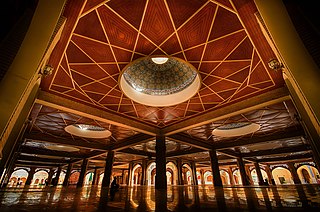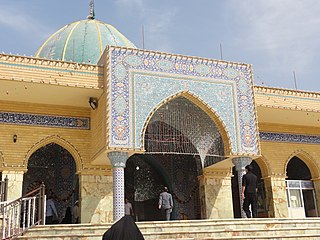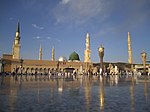
Karbala or Kerbala is a city in central Iraq, located about 100 km (62 mi) southwest of Baghdad, and a few miles east of Lake Milh, also known as Razzaza Lake. Karbala is the capital of Karbala Governorate, and has an estimated population of 711,530 people (2018).

The Sanctuary of Imām 'Alī, also known as the Mosque of 'Alī, located in Najaf, Iraq, is a mausoleum which many Shia and Sunni Muslims believe contains the tomb of 'Alī ibn Abī Tālib, a cousin, son-in-law and companion of the Islamic prophet Muhammad. The Shī'as consider 'Alī as their first Imām and the first of the twelve caliphs of Muhammad, and the Sunnis regard him as the fourth Sunni Rashid Caliph. According to Shī'ite belief, buried next to 'Alī within this mosque are the remains of Adam and Nuh (Noah). Each year, millions of pilgrims visit the Shrine and pay tribute to Imām 'Alī.

Husayn ibn Ali ibn Abi Talib was a prominent early Islamic figure. He was a grandson of the Islamic prophet Muhammad and a son of Ali ibn Abi Talib and Muhammad's daughter Fatima, as well as a younger brother of Hasan ibn Ali. He is regarded as the third Imam in Shia Islam after his brother, Hasan, and before his son, Ali ibn Husayn Zayn al-Abidin. Being a grandson of the prophet, he is a member of the Ahl al-Bayt. He is also considered to be a member of the Ahl al-Kisa, and a participant in the event of Mubahala. Muhammad described him and his brother, Hasan, as the leaders of the youth of Paradise.
Zayd ibn ʿAlī, also spelled Zaid, was the son of Ali ibn al-Husayn Zayn al-Abidin, and great-grandson of Ali ibn Abi Talib. He led an unsuccessful revolt against the Umayyad Caliphate, in which he died. The event gave rise to the Zaydiyya sect of Shia Islam, which holds him as the next Imam after his father Ali ibn al-Husayn Zayn al-Abidin. Zayd ibn Ali is also seen as a major religious figure by many Sunnis and was supported by the prominent Sunni jurist, Abu Hanifa, who issued a fatwa in support of Zayd against the Umayyads.

Kufa, also spelled Kufah, is a city in Iraq, about 170 kilometres (110 mi) south of Baghdad, and 10 kilometres (6.2 mi) northeast of Najaf. It is located on the banks of the Euphrates River. The estimated population in 2003 was 110,000. Currently, Kufa and Najaf are joined into a single urban area that is mostly commonly known to the outside world as 'Najaf'.

Al-Abbas ibn Ali ibn Abi Talib, also known as Abu al-Fadl, was a son of Ali ibn Abi Talib, the fourth caliph in Sunni Islam and the first imam in Shia Islam. His mother was Fatima bint Hizam, commonly known as Umm al-Banin. Abbas fought as the standard-bearer of his half-brother Husayn ibn Ali in the Battle of Karbala on 10 Muharram 61 AH against the army of the Umayyad caliph Yazid ibn Mu'awiya. He was killed in a desperate attempt to bring water from the Euphrates river to quench the unbearable thirst of the besieged family of the Islamic prophet Muhammad. Abbas is said to have inherited Ali's boldness and bravery, and was praised by Shia imams for his faith and fortitude in defending Husayn. Abbas is regarded by Shia Muslims as an ultimate paragon of courage and self-sacrifice. The shrine of Abbas and the nearby mausoleum of Husayn in Karbala are destinations for pilgrimage.

The holiest sites in Islam are predominantly located in the Arabian Peninsula and the Levant. While the significance of most places typically varies depending on the Islamic sect, there is a consensus across all mainstream branches of the religion that affirms three cities as having the highest degree of holiness, in descending order: Mecca, Medina, and Jerusalem. Mecca's Al-Masjid al-Haram, Al-Masjid an-Nabawi in Medina and Al-Masjid al-Aqsa in Jerusalem are all revered by Muslims as sites of great importance.

Al-Kazimiyya Mosque is a Shia Islamic mosque and shrine located in the Kādhimayn suburb of Baghdad, Iraq. It contains the tombs of the seventh and ninth Twelver Shī'ī Imāms, respectively Mūsā al-Kāẓim and his grandson Muhammad al-Jawad. Also buried within the premises of this mosque are the historical scholars Shaykh Mufīd and Shaykh Naṣīr ad-Dīn aṭ-Ṭūsi. Directly adjacent to the mosque are two smaller shrines, belonging to the brothers Sayyid Raḍī and Sayyid Murtadā and Qadi Abu Yusuf al-Ansari.

The al-Hussein Mosque or al-Husayn Mosque, also known as the Mosque of al-Imam al-Husayn and the Mosque of Sayyidna al-Husayn, is a mosque and mausoleum of Husayn ibn Ali, originally built in 1154, and then later reconstructed in 1874. The mosque is located in Cairo, Egypt, near the Khan El-Khalili bazaar, near-by the famous Al Azhar Mosque, in an area known as Al-Hussain. It is considered to be one of the holiest Islamic sites in Egypt. Some Shia Muslims believe that Husayn's head is buried on the grounds of the mosque where a mausoleum is located today and considered to be what is left of the Fatimid architecture in the building.

The Sayyidah Ruqayyah Mosque is located in Damascus, Syria, and contains the grave of Sukainah, also known as "Ruqayyah", the young daughter of Al-Husayn ibn Ali.

The Great Mosque of Kufa, or Masjid al-Kufa, is located in Kufa, Iraq and is one of the earliest surviving mosques in the world. The mosque, built in the 7th century, was home to Ali ibn Abi Talib, the 4th Rashidun caliph; and contains the shrine of Muslim ibn Aqeel, his companion Hani ibn Urwa, and the revolutionary, Al-Mukhtar. The mosque has been significantly rebuilt and restored multiple times in its history.

Both Sunni Muslims and Shia Muslims agree on the three holiest sites in Islam being, respectively, the Masjid al-Haram, in Mecca; the Al-Masjid an-Nabawi, in Medina; and the Al-Masjid al-Aqsa, in Jerusalem.

The Masjid al-Nuqtah (Arabic: مَسْجِد النُّقْطَة, romanized: Masjid an-Nuqṭah, lit. 'Mosque of the Drop [of the Blood of Husayn]' is a mosque located on Mount Jawshan in Aleppo, Syria. The main feature of the mosque is a stone believed to be stained with the blood of Husayn ibn ‘Alī by Muslims.

Musa ibn Ja'far al-Kazim was a descendant of the Islamic prophet Muhammad and the seventh imam in Twelver Shia Islam. Musa is often known by the title al-Kazim, apparently a reference to his patience and mild demeanor. He was born in 745 CE in Medina to Ja'far al-Sadiq, the sixth Shia imam, who died in 765 without publicly designating a successor to save his heir from the wrath of the Abbasid caliphs. The subsequent crisis of succession was eventually resolved in favor of al-Kazim, with a dissenting group, now known as the Isma'ilis, separating from the mainstream Shia.

The Al-Sahlah Mosque is one of the primary significant mosques in the city of Kufa, Iraq. The mosque is of great importance to Shia Muslims, and it is believed that the mosque was initially established in Kufa as a neighborhood mosque for the followers of Ali, the early members of the Shia. The mosque is also said to be the future home of the Twelfth Shia Imam, Hujjat-Allah al-Mahdi.
Ziyarat Ashura is an Islamic salutatory prayer to God. The prayer is part of the liturgy used in pilgrimages to the shrine of Husayn in Karbala. Muhammad al-Baqir, Prophet's descendant and the fifth Shia Imam, recommended reciting Ziyarat Ashura on Ashura while facing Karbala, as a symbolic visit to the shrine.
Lucknow is known as a city of imambaras as it contains a large number of them, among which, some are very well known.

Ayatollah al-Shaheed Sayyid Abū al-Fatḥ ʿIzz ad-Dīn Naṣrallāh ِal-Fāʾizī al-Mūsawī al-Ḥāʾirī, also known as Sayyid Nasrallah al-Haeri, was a senior Iraqi Shia jurist, teacher, poet, author and annalist.

The Mausoleum of Kumayl ibn Ziyad is a shrine dedicated to Kumayl ibn Ziyad al-Nakha'i, a companion of the fourth Rashidun Caliph, Ali ibn Abi Talib. It is located on the metropolis of Najaf and Kufa, Iraq, adjacent to the Al-Hannanah Mosque.























